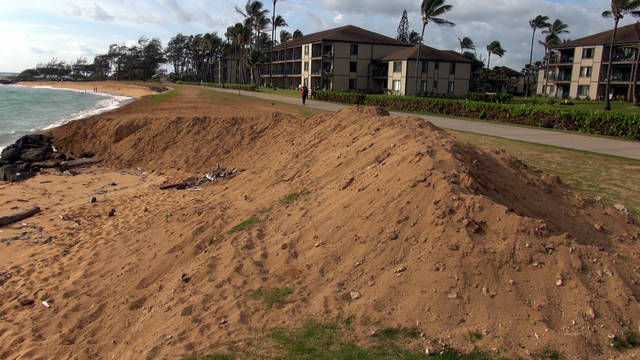KAPAA — The county is adding sand at the north end of the Pono Kai Seawall in Kapaa, but concerns are being raised about the effect on coral reefs in the area. “We did receive an email from the member
KAPAA — The county is adding sand at the north end of the Pono Kai Seawall in Kapaa, but concerns are being raised about the effect on coral reefs in the area.
“We did receive an email from the member of the public expressing his concern about the beach nourishment project near the Waikea Boat Ramp and Pono Kai Hotel,” said acting county engineer Lyle Tabata.
The concern is that the sand is getting washed into the reef, clogging the boat ramp area and the stream mouth, and ultimately killing the coral.
The email, submitted by Terry Lilley, a Hanalei biologist and environmental activist, alleges the project is a violation of the federal Clean Water Act because the action is killing the coral reef.
“The entire reef is 99 percent dead and covered in sediment,” Lilley writes in the email. “This area was healthy just a few short years ago. We are doing an extensive study of the corals in the Kapaa Lagoon and (in) most locations there is a 10 to 35 percent live coral cover but this location is less than a 1 percent live coral cover.”
“While we cannot speculate on the cause of the alleged reef damage, you may want to contact the Department of Land and Natural Resources (DLNR), Office of Conservation and Coastal Lands who has the expertise in marine and coral reef ecosystems,” Tabata told TGI.
Representatives from DLNR said the department is looking into the complaint, but provided no further information.
The county began the beach nourishment project last year after obtaining the required permit from OCCL, according to Tabata.
The Pono Kai Seawall has long been a fixture in Kapaa but has been deteriorating for at least eight years. In 2015, a $948,400 project to repair the 600-foot seawall was put into full swing.
The project was finished in September 2015, but the problem with periodic beach erosion wasn’t fixed.
In April, Tabata told TGI the issue stems from the scope of the repair project, which was limited to repairing the crumbling wall instead of extending it 50 feet, as was recommended.
In order to extend the wall, the county would have to apply for additional permits, including a conservation district use permit, U.S. Army Corps of Engineers permit, Department of Health clean water branch permit, and a special management area permit.
So instead, the county obtained a 10-year permit from DLNR for periodic beach nourishment after erosion events wash the beach out to sea.
It usually takes between two and four weeks for the county to respond to each individual erosion event and replace the sand.
Since April 2016, there have been four beach nourishment activities with a total of 500 cubic yards of sand placed above the mean high water mark.
The work is being done in accordance with the requirements set forth by the OCCL, including the recommended sand quality, Tabata said.
But Lilley said the county doesn’t have a permit to kill a coral reef with its beach replenishment project.
“This added sand is going out onto the reef killing the corals,” he wrote.
“It is not legal to kill a coral reef here in Kauai no matter what state or county permit you may have! Protecting private property from rising sea levels does not void out all our good federal laws protecting our coral reefs and the habitat for our endangered species.”
Lilley said his main concern is to stop the damage to the reefs in this area because it is an important cultural fishing spot “that currently has no fish left.”




